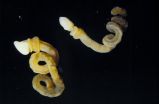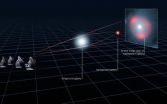(Press-News.org) University of Montreal researchers found that changes in gravity affect the reproductive process in plants. Gravity modulates traffic on the intracellular "highways" that ensure the growth and functionality of the male reproductive organ in plants, the pollen tube. "Just like during human reproduction, the sperm cells in plants are delivered to the egg by a cylindrical tool. Unlike the delivery tool in animals, the device used during plant sex consists of a single cell, and only two sperm cells are discharged during each delivery event," explained Professor Anja Geitmann of the university's Department of biology. "Our findings offer new insight into how life evolved on Earth and are significant with regards to human health, as a traffic jam on these highways that also exist in human cells can cause cancer and illnesses such as Alzheimer's."
The interior of animal and plant cells is like a city, with factories—called organelles—dedicated to manufacturing, energy production and waste processing. A network of intracellular "highways" enables the communication between these factories and the delivery of cargo between them and between the inside of the cell and its external environment. Plant cells have a particularly busy highway system. "Researchers already knew that humans, animals and plants have evolved in response to Earth's gravity, and that they are able to sense it," Geitmann explained. "What we are still discovering is how the processes occurring within the cells of the human and plant bodies are affected by the more intense gravity, or hypergravity, that would be found on a large planet, or the microgravity that resembles the conditions on a space craft. Intracellular transport processes are particularly sensitive to disturbance, with dramatic consequences for cell functioning. How these processes are affected by a change in gravity is poorly understood."
The cells were placed into a large centrifuge, along with a camera attached to a microscope, enabling the researchers to track in real time how the cells develop in the intense gravity generated by the centrifuge. "Thanks to the facilities at the European Space Agency, I was able to determine how hypergravity and simulated microgravity affect the intracellular trafficking in the rapidly growing pollen tube," explained Dr. Youssef Chebli, a researcher in Geitmann's lab. "We chose pollen, the carrier of the male sperm cells, as our model because of its pivotal role in plant reproduction and agriculture and because of its extraordinarily rapid growth, meaning that we could observe the effects of the hypergravity within seconds."
The researchers stained specific structures within the cells, which revealed how the cellular components move around and how the cellular transport logistics responds to the changing gravity environment. "We found that intracellular traffic flow is compromised under hyper-gravity conditions and that both hyper and microgravity affect the precisely coordinated construction of the cellular envelope in the growing cell," Chebli said. "This allows us not only to understand general principles of the reproductive mechanism in plants but, more importantly, how the intracellular transport machinery in eukaryotic cells responds to altered gravity conditions. Our findings have implications for human health as similar effects are likely to occur in human cells such as neurons where long distance intracellular transport is crucial."
Chebli and Geitmann's study will be published in the journal PLOS ONE on March 13, 2013. Link: http://dx.plos.org/10.1371/journal.pone.0058246
INFORMATION:
About the study:
Chebli and Geitmann's research was undertaken at the Large Diameter Centrifuge facility at European Space Agency's European Space Research and Technology Centre (ESTEC) in Noordwijk, the Netherlands. They have been invited to perform their experiments there under the 'Spin Your Thesis!' programme, which gives university students the opportunity to perform a scientific or technology experiment which is linked to their syllabus, by participating in a centrifuge campaign that provides hypergravity conditions.
Dr. Geitmann's research is funded in part by the National Science and Engineering Research Council of Canada and the Fonds de recherche du Québec – Nature et technologies.
About the researchers:
Anja Geitmann, PhD
Full professor, Department of Biological Sciences, University of Montreal
Researcher, Institut de recherche en biologie végétale, University of Montreal
Youssef Chebli, PhD
Postdoctoral researcher, Geitmann Laboratory, Department of Biological Sciences and Institut de recherche en biologie végétale, University of Montreal
Editorial note:
The University of Montreal is officially known as Université de Montréal.
Sex at zero gravity
Hyper and micro-gravity affect processes involved in reproduction, brain diseases and cancer
2013-03-14
ELSE PRESS RELEASES FROM THIS DATE:
Vitamin D supplements may help African Americans lower blood pressure
2013-03-14
Vitamin D supplements significantly reduced blood pressure in the first large controlled study of African-Americans, researchers report in the American Heart Association journal Hypertension.
In the prospective trial, a three-month regimen of daily vitamin D increased circulating blood levels of vitamin D and resulted in a decrease in systolic blood pressure ranging from .7 to four mmHg (depending upon the dose given), compared with no change in participants who received a placebo.
Systolic blood pressure, the top and highest number in a reading, is pressure in the arteries ...
Feynman's double-slit experiment brought to life
2013-03-14
The precise methodology of Richard Feynman's famous double-slit thought-experiment – a cornerstone of quantum mechanics that showed how electrons behave as both a particle and a wave – has been followed in full for the very first time.
Although the particle-wave duality of electrons has been demonstrated in a number of different ways since Feynman popularised the idea in 1965, none of the experiments have managed to fully replicate the methodology set out in Volume 3 of Feynman's famous Lectures on Physics.
"The technology to do this experiment has been around for about ...
No attention-boosting drugs for healthy kids, doctors urge
2013-03-14
Doctors at Yale School of Medicine and the American Academy of Neurology (AAN) have called upon their fellow physicians to limit or end the practice of prescribing memory-enhancing drugs to healthy children whose brains are still developing. Their position statement is published in the March 13 online issue of the journal Neurology, the medical journal of the AAN.
The statement was written to address the growing trend in which teens use "study drugs" before tests and parents request attention deficit hyperactivity disorder (ADHD) drugs for children who don't meet the ...
Strange phallus-shaped creature provides crucial missing link
2013-03-14
This press release is available in French.
Christopher Cameron of the University of Montreal's Department of Biological Sciences and his colleagues have unearthed a major scientific discovery - a strange phallus-shaped creature they found in Canada's Burgess Shale fossil beds, located in Yoho National Park. The fossils were found in an area of shale beds that are 505 million years old.
Their study, to be published online in the journal Nature on March 13, 2013, confirms Spartobranchus tenuis is a member of the acorn worms group which are seldom-seen animals that thrive ...
Burgess Shale worm provides crucial missing link
2013-03-14
Canada's 505 million year-old Burgess Shale fossil beds, located in Yoho National Park, have yielded yet another major scientific discovery – this time with the unearthing of a strange phallus-shaped creature.
A study to be published online in the journal Nature on March 13 confirms Spartobranchus tenuis is a member of the acorn worms group which are seldom-seen animals that thrive today in the fine sands and mud of shallow and deeper waters. Acorn worms are themselves part of the hemichordates, a group of marine animals closely related to today's sea stars and sea ...
NIST mechanical micro-drum used as quantum memory
2013-03-14
BOULDER, Colo.— One of the oldest forms of computer memory is back again—but in a 21st century microscopic device designed by physicists at the National Institute of Standards and Technology (NIST) for possible use in a
quantum computer.
The NIST team has demonstrated that
information encoded as a specific point in a
traveling microwave signal—the vertical and horizontal positions of a wave pattern at a certain time—can be transferred to the mechanical beat of a micro-drum and later retrieved with 65 percent efficiency, a good figure for experimental systems like this. ...
ALMA rewrites history of Universe's stellar baby boom
2013-03-14
Observations with the Atacama Large Millimeter/submillimeter Array (ALMA) show that the most vigorous bursts of star birth in the cosmos took place much earlier than previously thought. The results are published in a set of papers to appear in the journal Nature and in the Astrophysical Journal. The research is the most recent example of the discoveries coming from the new international ALMA observatory, which celebrates its inauguration today.
The most intense bursts of star birth are thought to have occurred in the early Universe, in massive, bright galaxies. These ...
New MRI method fingerprints tissues and diseases
2013-03-14
A new method of magnetic resonance imaging (MRI) could routinely spot specific cancers, multiple sclerosis, heart disease and other maladies early, when they're most treatable, researchers at Case Western Reserve University and University Hospitals (UH) Case Medical Center suggest in the journal Nature.
Each body tissue and disease has a unique fingerprint that can be used to quickly diagnose problems, the scientists say.
By using new MRI technologies to scan for different physical properties simultaneously, the team differentiated white matter from gray matter from ...
Joslin scientists discover mechanism that regulates production of energy-burning brown fat
2013-03-14
BOSTON – March 13, 2013 – Joslin scientists have discovered a mechanism that regulates the production of brown fat, a type of fat which plays an important role in heat production and energy metabolism. The findings, which appear in the upcoming issue of Nature, may lead to new therapies that increase BAT formation to treat obesity.
Two types of fat tissue are present in humans and other mammals: white adipose tissue (WAT) or white fat, which stores fat; and brown adipose tissue (BAT) or brown fat, which burns fat to produce heat. Brown fat also metabolizes glucose and ...
Tobacco industry appears to have evaded FDA ban on 'light' cigarette descriptors
2013-03-14
Boston, MA – New research from Harvard School of Public Health (HPSH) shows that one year after the federal government passed a law banning word descriptors such as "light," "mild," and "low" on cigarette packages, smokers can still easily identify their brands because of color-coding that tobacco companies added to "light" packs after the ban. These findings suggest that the companies have, in effect, been able to evade the ban on misleading wording—thus still conveying the false and deceptive message that lights are safer than "regular" cigarettes.
In addition, the ...
LAST 30 PRESS RELEASES:
Norbert Holtkamp appointed director of Fermi National Accelerator Laboratory
New agentic AI platform accelerates advanced optics design
Biologists discover neurons use physical signals — not electricity — to stabilize communication
Researchers discover that a hormone can access the brain by hitchhiking
University of Oklahoma researcher awarded funding to pursue AI-powered material design
Exploring how the visual system recovers following injury
Support for parents with infants at pediatric check-ups leads to better reading and math skills in elementary school
Kids’ behavioral health is a growing share of family health costs
Day & night: Cancer disrupts the brain’s natural rhythm
COVID-19 vaccination significantly reduces risk to pregnant women and baby
The role of vaccination in maternal and perinatal outcomes associated with COVID-19 in pregnancy
Mayo Clinic smartwatch system helps parents shorten and defuse children's severe tantrums early
Behavioral health spending spikes to 40% of all children’s health expenditures, nearly doubling in a decade
Digital cognitive behavioral treatment for generalized anxiety disorder
Expenditures for pediatric behavioral health care over time and estimated family financial burden
Air conditioning in nursing homes and mortality during extreme heat
The Alps to lose a record number of glaciers in the next decade
What makes a good proton conductor?
New science reporting guide published for journalists in Bulgaria
New international study reveals major survival gaps among children with cancer
New science reporting guide published for journalists in Turkey
Scientists develop a smarter mRNA therapy that knows which cells to target
Neuroanatomy-informed brain–machine hybrid intelligence for robust acoustic target detection
Eight SwRI hydrogen projects funded by ENERGYWERX
The Lundquist Institute and its start-up company Vitalex Biosciences Announces Strategic Advancement of Second-Generation fungal Vaccine VXV-01 through Phase 1 Trials under $40 Million Competitive Con
Fine particles in pollution are associated with early signs of autoimmune disease
Review article | Towards a Global Ground-Based Earth Observatory (GGBEO): Leveraging existing systems and networks
Penn and UMich create world’s smallest programmable, autonomous robots
Cleveland researchers launch first major study to address ‘hidden performance killer’ in athletes
To connect across politics, try saying what you oppose
[Press-News.org] Sex at zero gravityHyper and micro-gravity affect processes involved in reproduction, brain diseases and cancer




